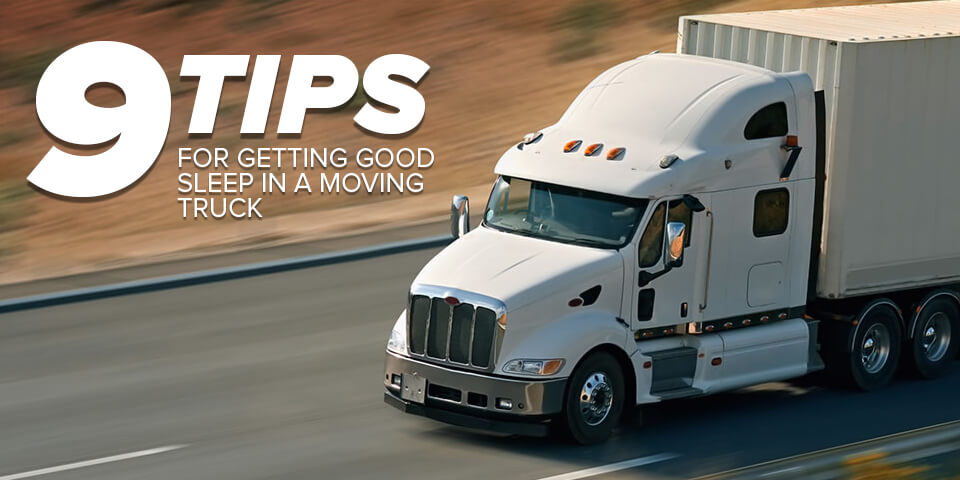Driver Lifestyles

9 Tips for Getting Good Sleep in a Moving Truck
If you’re operating as a team, you’ll spend the bulk of your sleep time while the truck is moving, and this can create challenges with getting the sleep you need to avoid fatigue and burnout that could put your (and your partner’s) safety at risk.
So, what can you do to improve your quality of sleep in a moving truck? Here are nine tips.
1. Make your mattress as comfortable as possible
“Having a good mattress and pillow helps a lot,” says Heather Hutchens, an expedite owner-operator with her husband Jason. “A good foam mattress on top of a spring mattress does wonders with helping to reduce bouncing while the truck is moving. One good brand we’ve heard of and plan on purchasing ourselves in the near future is made by a company called SleepDog Mattress. We’ve also had good experience with the My Pillows as they come in a variety of firmness levels based on your preference.”
2. Clear your mind.
How?
“By putting the phone down and reading for a bit,” says long-time expediter Linda Caffee. “This will help quiet the mind and get you drowsy for quality sleep.”
While some people have no issue using electronic devices--like an e-reader, smartphone or laptop--prior to sleep, the National Sleep Foundation says that those devices emit a type of light that is activating to the brain, which could keep you awake. So, experiment to see what works o.k. for you.
3. Keep the sleeper at a comfortable temperature.
Don’t try to “tough it out” with the sleeping quarters being too warm or chilly. Whether the truck is in motion or parked, the name of the game is to maintain a sleeper temperature that provides maximum comfort for the highest quality sleep.
4. Make the sleeper as dark as possible.
Bob and Linda Caffee recommend using plastic chip clips (that seal potato chip bags) to ensure the curtains between the truck cab and sleeper stay shut, preventing light from coming in. Also, try using eye shades.
5. Block out road noise.
You won’t be able to avoid road noise altogether but you can help block it out by using earplugs or downloading a “white noise” app to your smartphone.
“We have used earplugs and are using the vinyl coverings over the sleeper windows to help reduce noise, as well,” says Hutchens. “And playing ambient sounds in the background, like nature sounds, may help some with relaxing and drowning out road noise to fall asleep faster. One [track] that Jason likes to listen to is called Weightless by Marconi Union.”
6. Eliminate rattles.
Instead of regular dishes, carry paper and plastic plates, utensils and cups. This way, you won’t be kept awake by dishes, glasses and silverware rattling as the truck travels down the road.
Keep the sleeper quiet or use a fan as well as the air conditioner to help deaden outside noise as trucks drive past
7. Be mindful about helping the non-driving partner sleep.
Work with your partner so that you both drive and behave in a way that won’t disturb each other’s sleep. Avoid rapid acceleration and hard braking. Ease into lane changes. Plan fuel stops with driver change, which helps minimize the number of stops that could wake the partner who is sleeping.
“The person who is driving must be very aware of their driving movements while the other driver is sleeping. If they are hard on the brakes to stop or are heavy on the acceleration pedal--that can make the truck rock and move in a way that’s amplified in the sleeper,” says Hutchens.
In terms of behavior in the cab, Linda says that she and Bob keep it simple: “We have a rule: No laughing out loud at jokes you hear and NO SINGING out loud!”
8. Regulate caffeine intake.
Caffeine lasts for about five to six hours in the body before wearing off, says the National Sleep Foundation. So, minimize the effects of caffeine on your sleep by timing your last cup of coffee or any other caffeinated beverage about six hours before you plan to sleep.
9. Stay on schedule.
“Another thing that helps us sleep is trying to stay on a schedule as much as possible,” says Hutchens. “For instance, we do 12-hour shifts and try to keep them close to one-to-one as possible. If you are driving nights one week then have to drive days the next, that can throw off your internal clock and make it hard to get adequate sleep. It may take some time tweaking the hours, but once you find what times work best for both drivers it makes it a lot easier for sleep.”
The Bottom Line
The U.S. Department of Transportation says that driver fatigue is a leading cause of nearly 4,000 fatalities in large truck crashes each year. So, protect yourself, your partner, and the public by doing everything you can to get quality sleep while you’re out on the road.
